Back Widow
bodyweight rear delt raise
How to Do the Back Widow Lying Rear Delt Exercise - no equipment | In-Depth Guide [VISUAL LEARNERS] Beginner
Proper Form, Common Mistakes, & Variations + Easier Variation | Home Resistance Training
WHAT DO YOU WANT TO SEE?
QUICK DEMO
QUICK DEMO
MUSCLES THIS WORKS
MUSCLES
MAIN MUSCLES WORKED IN the Back Widow
Rear Deltoid
OTHER MUSCLES WORKED:
- Anterior and lateral portions of the deltoid
- Rotator cuff muscles
- Scapular muscles (rhomboids, traps, serratus, pectoralis, lats, levator)
WHAT WE'RE DOING TODAY
WHAT & WHY
BENEFITS OF TRAINING THE rear deltoid
WHAT
WHAT WE'RE DOING TODAY
ALL WE'RE DOING:
This one is a bit odd, BUT it's laying down, so stick around.
BODYWEIGHT EXERCISES FOR THE BACK OF OUR SHOULDER
This group of rear deltoid exercises uses body weight as resistance. The body weight exercises involve holding the body still and using the rear deltoid muscle to move the body. Using body weight for resistance has many benefits, the most obvious one is that you don’t need any equipment, making them a good choice for home or travel workouts. Body weight exercises usually require more balance, control, and stability; they tend to work the whole body, making them very functional, and efficient when you are short on time.
Body weight training improves stability and control, adding some of these exercises into your workout program will improve your ability to lift more. An analogy would be - trying to hang a bird feeder from a small branch of a tree - the branch would sag down. If the branch was more stable and didn’t bend, the branch would not sag down. Building the strength of the muscles of the upper back and shoulder will help you be able to lift more weight with your arms.
WHY BOTHER DOING IT?
WHY
WHY DO WE EVEN CARE?
STRENGTHEN THE BACK OF US TO BALANCE THE FRONT
Many common weight training exercises are done in front or to the side of the body, these are great for working the front and middle portions of the deltoid muscles. In order to balance the strength of these parts of the muscle, it is important to include exercises that target the rear or posterior fibers of the deltoid muscle. The body weight rear deltoid exercises will target the rear deltoid while working all of the muscles of the shoulder together to stabilize the joint and control the movement.
SOOOO MUCH ACTIVITY WITH OUR FRONTS
Most daily activities are carried out in front of our bodies - carrying heavy loads (kids, bags), computer work, driving, reading, eating, cooking, and pushing strollers and wheelbarrows. All of this activity tightens the muscles of the chest and encourages rounding of the upper back and shoulders. Over time the muscles of the back become weaker from disuse. This exercise works to correct this imbalance and improve posture.
The bodyweight exercises are really nice because they work on increasing the endurance of the muscles that hold you in the upright position. That means that you are training the muscle to work for a longer period of time. This is important because that is the way that we use the posture muscles - we are sitting or standing in an upright position for most of the day. We might be standing nice and tall at the beginning of the day but as the day goes on, we start to slouch. Exercise is not only about strengthening muscles, it is about teaching your body how to use them.
EVERYDAY LIFE
EVERYDAY LIFE &
MUSCLE FUNCTION
HOW WE USE OUR rear deltoid IN EVERYDAY LIFE
1. STABILIZES THE SHOULDER
- Keeps the head of the humerus centered in the socket (glenoid fossa)
- Pushing up from the floor
- Lifting
- Carrying, especially heavy loads
- Weeding
- Helps to prevent damage to the shoulder joint- wear and tear over time due to poor movement patterns
2. MOVES THE ARM BACK (EXTENSION)
- Reaching behind the back
- Pulling items towards you
- Reaching into the back seat
3. HELPS TO MAINTAIN AN UPRIGHT POSTURE
4. ROTATING THE UPPER ARM OUTWARD (EXTERNAL ROTATION)
- Putting your hand in the back pocket (palm down)
- Turning outstretched arm with palm up for receiving change
- Catching a ball
- Reaching the back of your head
- Washing/brushing/drying hair
STARTING POINTERS
Starting Pointers
This is a challenging exercise that works the rear deltoid muscles for endurance - keeping the muscles active for a long time. The exercise not only works the rear deltoid but the muscles of the torso. This is a great exercise to do at the end of a long day of sitting. Works the muscles needed to correct slouched or stooped posture, stretching the muscles of the chest while strengthening the muscles of the back.
HOW TO FEEL WHAT MUSCLE IS WORKING
How to Feel What Muscle is Working
Take your opposite hand and place it on top of your shoulder. You should feel a hard, flat surface right on top close to the shoulder joint. That is part of the shoulder blade called the acromion process. Drop your fingers right below that bony surface. Hold your upper arm up (approximately 50 - 60 degrees of abduction) with the elbow bent. Push the upper arm back. You should feel the rear fibers of the deltoid activate under your fingers. It can help to push your elbow into the back of the chair or a wall.
HOW TO DO THE EXERCISE
LOOKS
HOW Back WidowS SHAPE OUR BODY
Balanced and toned shoulder, arms, nice upright posture.
PROPER FORM
PROPER FORM: Back Widow
EQUIPMENT, SETS & REPS
EQUIPMENT
Mat
SUGGESTED STARTING WEIGHT FOR WOMEN:
Bodyweight
SETS & REPS:
1 set of 6-10 reps - only until your form fails - when you are unable to complete a rep with proper form and control.
PACE:
Controlled up and down - not jerking upwards and dropping down.
BODY POSITION
BODY POSITION FOR THE Back Widow
BODY STANCE: Lying on your back with knees bent. Neutral spine (you should be able to put a hand under the curve of your low back, sternum lifted, and space between the top of the shoulders and the ear lobe.
FEET: Feet flat on the floor hip-width apart.
ARMS: Move your arms out away from your sides, about 45 degrees from your body. Bend your elbows so that your forearms are off the floor -your forearm approximately perpendicular to the floor (90 degrees of elbow bend) is usually most comfortable.
NECK: Your neck must be protected from muscle strain - elongate the back of your neck and gently tilt your chin downward*, maintain this position throughout the exercise.
*Bringing your chin down just a tad before your press down to lift your trunk off of the floor will keep your neck in neutral. This is not a notable flexion of the cervical spine, it is just a position to engage your cervical flexors to prevent extension.
HOW TO DO
HOW TO DO Back Widow
CUE: You should feel like your torso is one piece, the pivot point for the movement is the lower part of your sacrum.
Squeeze your shoulder blades in and down your back. Press your elbows down into the floor to lift your torso off of the floor.
Your torso should lift up in one piece - a straight line (angled upwards towards the ceiling from hip to earlobe) from your hip to your shoulder to your earlobe.
Pause at the top of the movement and then lower your back down with control.
Repeat to fatigue - fatigue is when you are no longer able to complete with good form. This is usually limited by neck flexor weakness, or core weakness - unable to maintain your torso in a straight line and begin to just lift your upper back off of the floor (bending at low back).
HOW TO SAFELY GET OUT OF THE EXERCISE
Roll on to your stomach, push back into child’s pose and stand up.

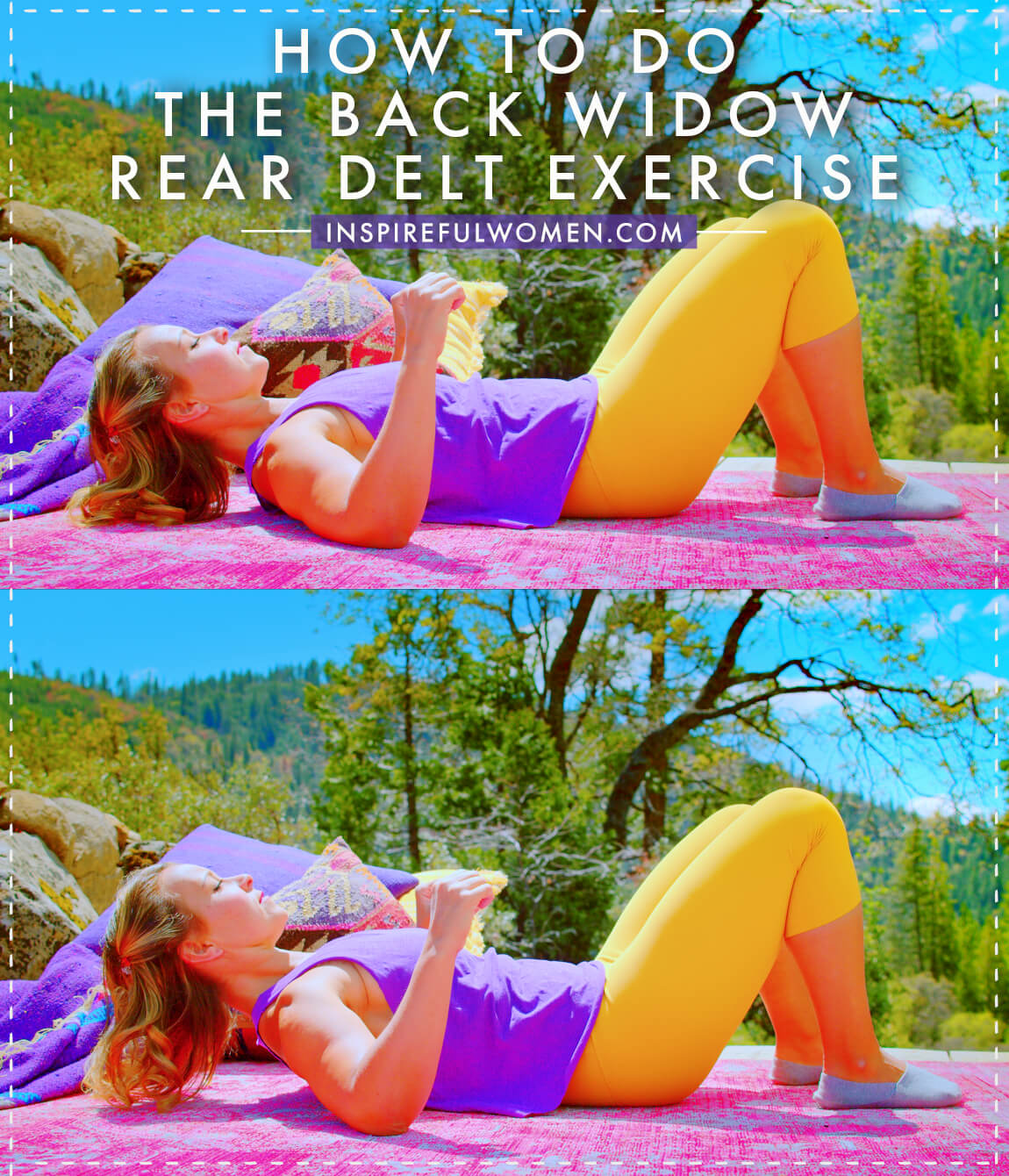
COMMON MISTAKES
COMMON MISTAKES
WHAT TO AVOID WITH THE Back Widow
KEY TIP:
Guess what? Good news! Many avoids are the same for most movements. Once you learn the basics, there's really only a few extra avoids for each individual movement.
1. Avoid arching spine
AVOID: Avoid arching the back or flexing the back (flattening the curve of the low back).
WHAT TO DO:
- Maintain a neutral spine position to avoid injury or muscle strain.
- It is helpful to have a mirror that they can check for alignment
- Lead with the sternum and think of lifting the whole torso down to the sacrum in one segment- not leading with the belly button or the shoulders (without the hips).
- Concentrate on how it feels, it is important to be able to self-monitor a neutral spine position.
- If the shoulders lift before the sacrum then you are flattening your back
- If the belly button pushes up towards the ceiling then you are arching your back.
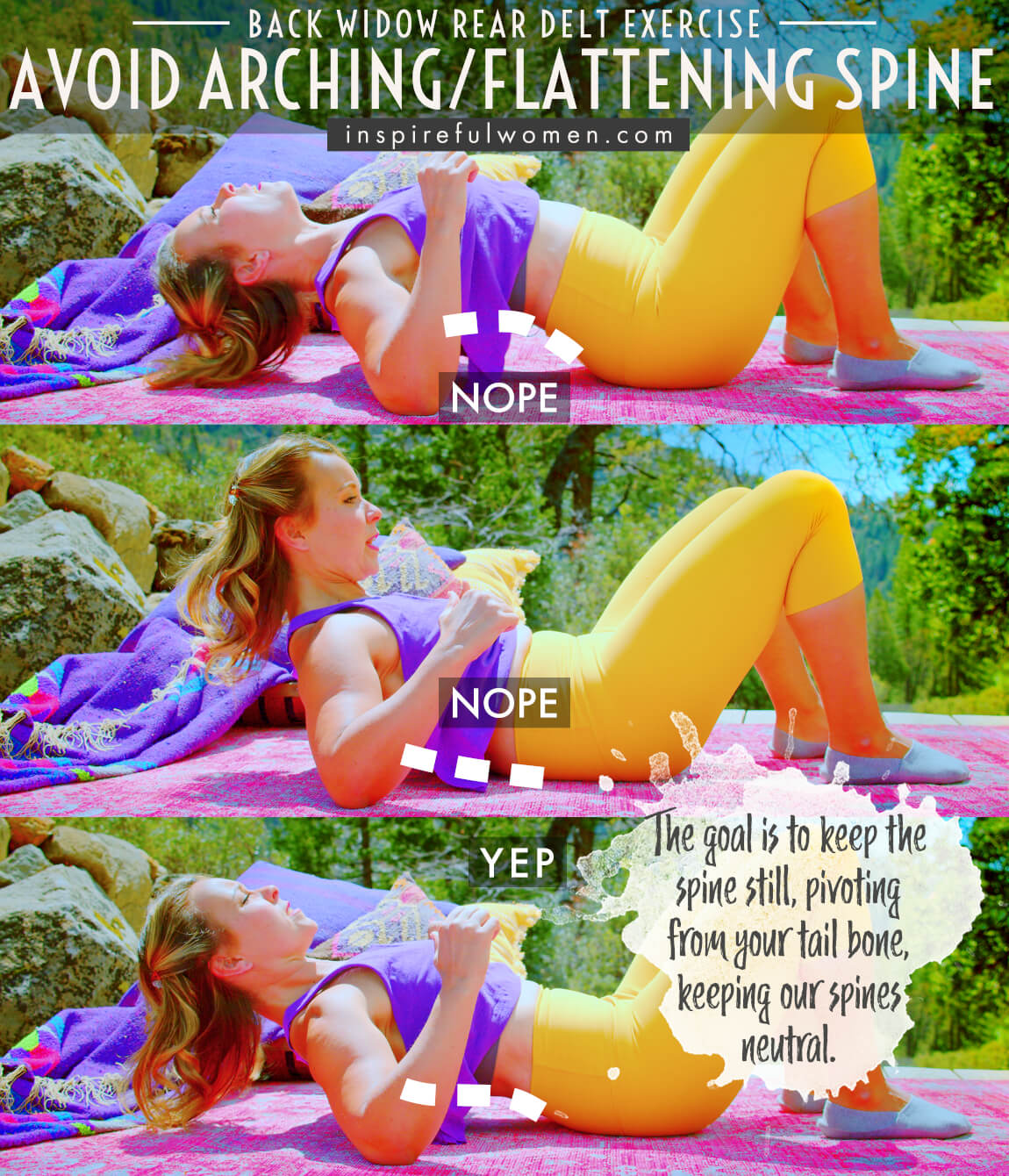
2. Avoid head dropping down
AVOID: Avoid leaving the weight of the head behind.
WHY NOT?
- Neck should not fall back into extension as the body is pressed up.
- This can result in straining the neck muscles.
WHAT TO DO:
- Try tucking the chin just a bit.
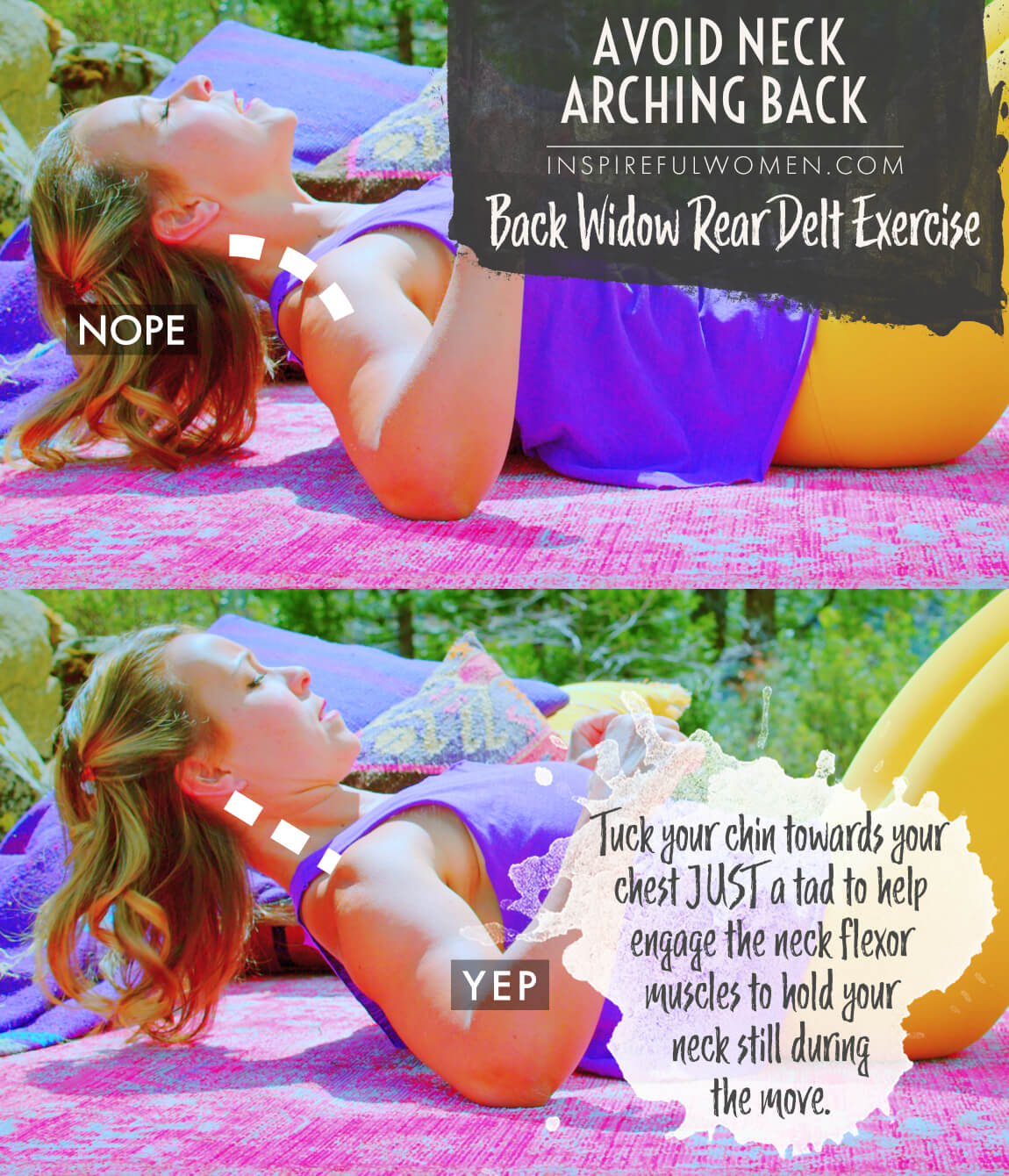
VARIATIONS
VARIATIONS
VARIATIONS OF Back Widow
arms closer or further away
arms closer or further away
ARM POSITION OPTIONS:
- Positioning the arms closer to the body (less than 45 degrees of abduction) will decrease the effort of the posterior deltoid and increase the activity of the latissimus dorsi.
- Positioning the arms further away from the body (more than 45 degrees of abduction) will increase the rear deltoid muscle activity.
- Placing the back of the forearm on the floor, so the shoulder externally rotated (soft side up), will increase the activity of the rear deltoid, and decrease the help from the lat, teres major, and the triceps.
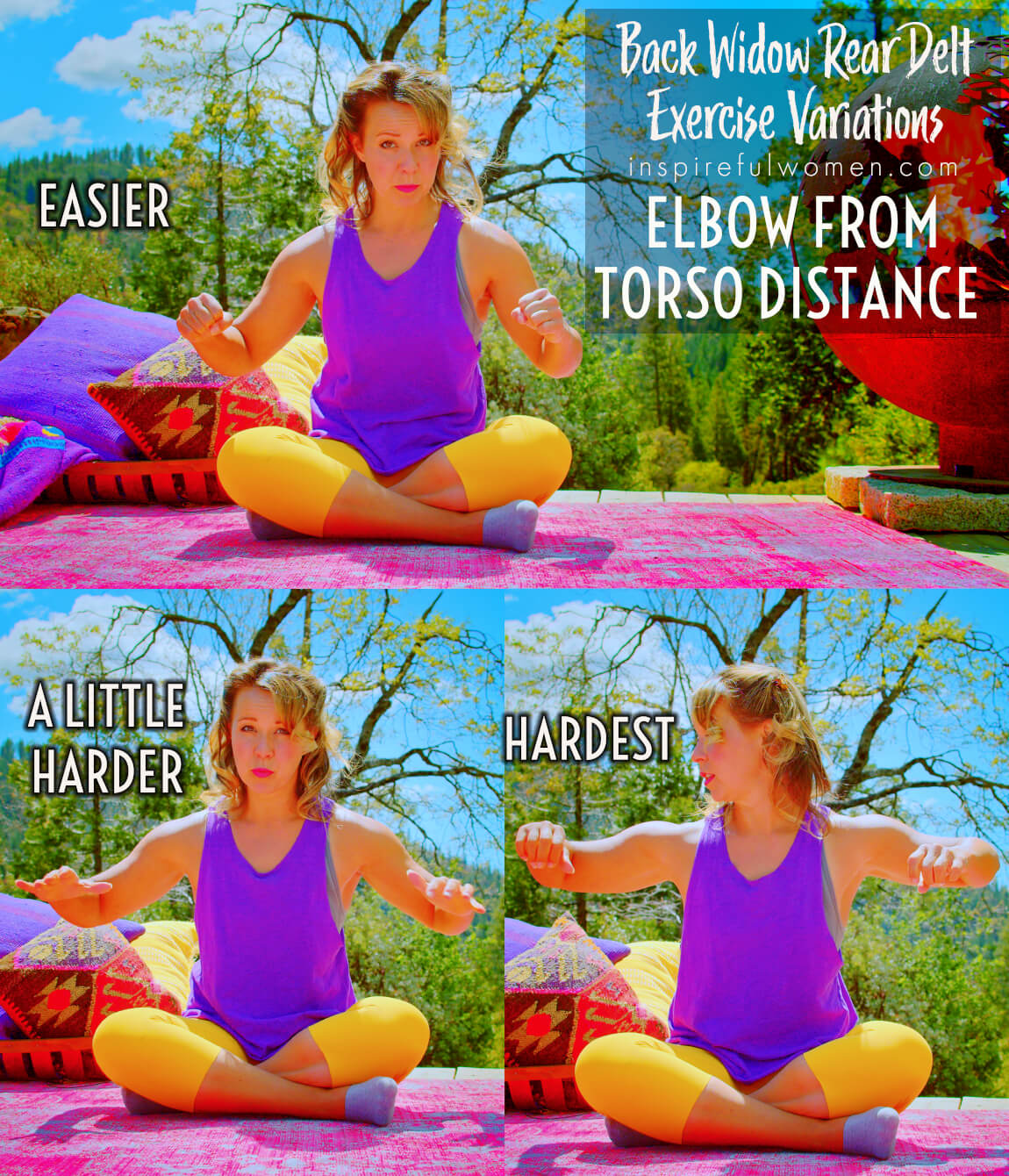
stability ball
Calves on stability ball
Place the calves on the ball with the knees and hips bent. This option will work the lower abdominals more to stabilize the torso. The gluteus maximus and hamstrings will also be more active. Your sacrum still says on the floor. Having the legs straighter will be easier than having them bent - play around with the positioning until you find a place where you have good form while still being challenged.
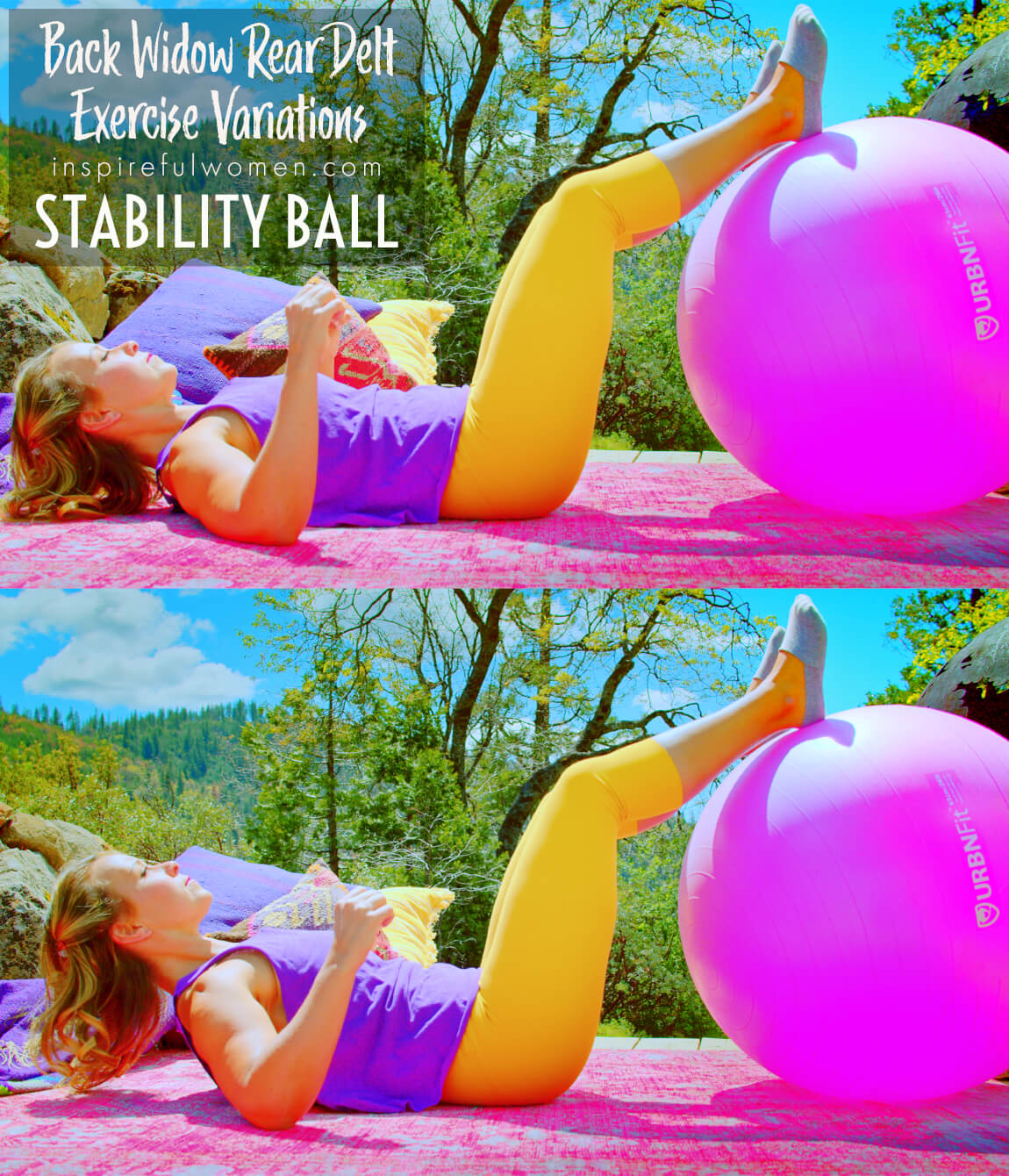
MAKE IT EASIER
EASIER
MAKE THE Back Widow MORE DOABLE
press into floor
press into floor Only
Push down into the floor but do not worry about lifting the body up. Leave your head and shoulders on the floor, and push into the floor to lift your spine off of the floor. Unweighting the torso but not lifting the whole trunk off.

blankets under elbows
blankets under elbows
Put folded-up blankets or exercise mats under each elbow to position the arm in a more forward position to start from.
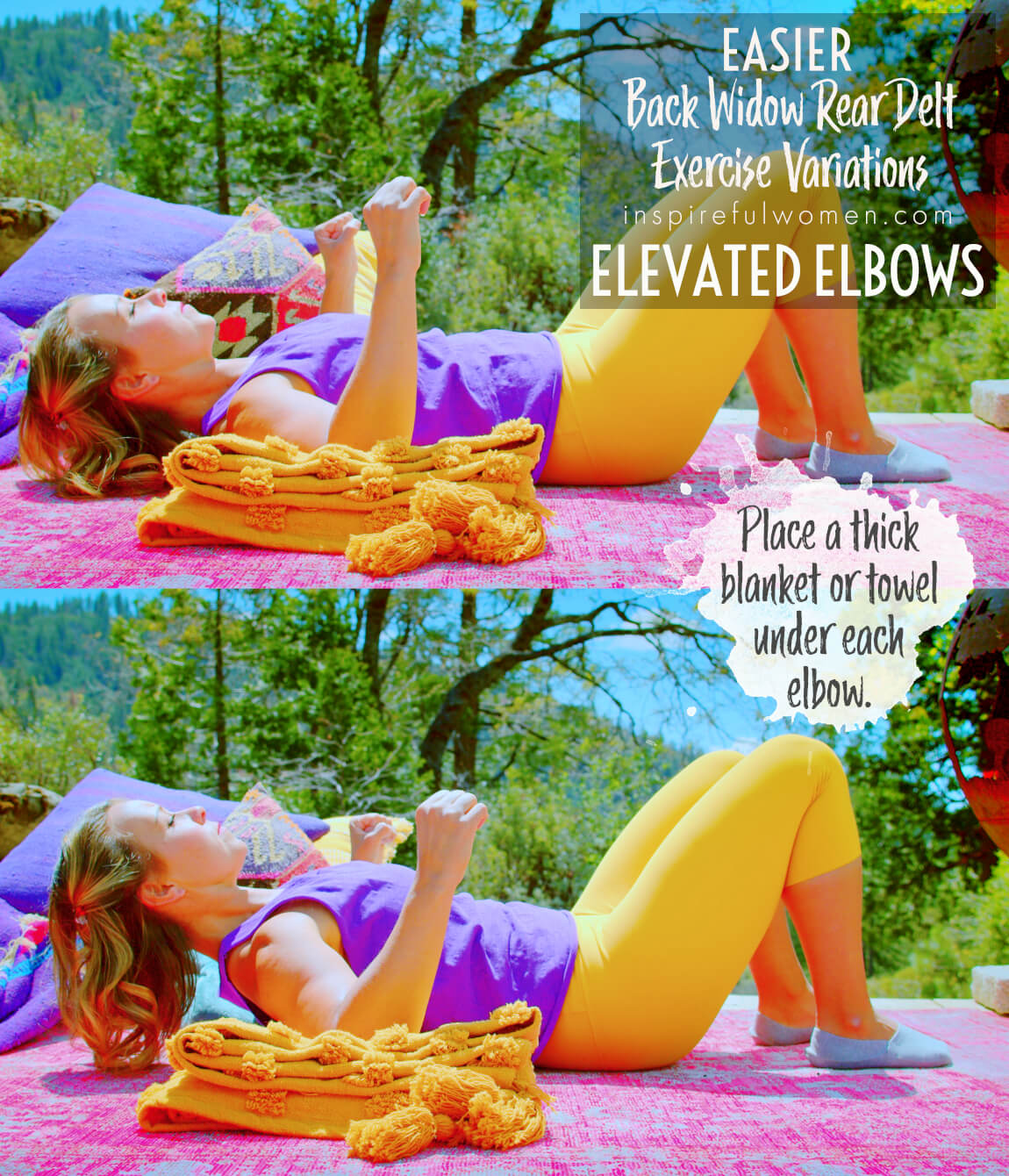
SCIENCY STUFF
SCIENCY STUFF
SPIFFILICIOUS FACTS ABOUT MUSCLES & MOVES
The deltoid muscle lies on top of the shoulder and crosses the shoulder joint. The deltoid muscle consists of three portions, based on how the muscle fibers run, the anterior (front), lateral (middle), and posterior (rear) deltoids. The three parts of the deltoid muscle can move the arm in different directions but they all work together to stabilize the joint.
The posterior or rear fibers of the muscle are located on the back of the shoulder joint - originating just below the spine (the long horizontal part of the shoulder blade) of the scapula and insert on the humerus (upper arm bone). The posterior deltoid is very important for balancing out the frequently overworked anterior deltoid and hours of slouched posture during sitting activities like computer use and driving, as well as household work - cooking, washing, carrying, lifting, and chopping. We are constantly doing activities that promote a rounded shoulder and upper back posture; it is important to spend some time working on the muscles that balance that posture out.
This movement uses the weight of the body for the load (resistance) used to work the muscles of the back that help to balance the frequently overdeveloped muscles of the chest. Body weight rear deltoid exercises focus on the stability of the shoulder joint and shoulder blade for healthier movement of the shoulder joint and improved posture.
ALLLL MUSCLES & WHEN
ALL MUSCLES WORKING & WHEN DURING THE Back Widow
The core stabilizers work to hold the spine in a neutral position throughout the exercise.
The cervical (neck) flexors work to hold the cervical spine in neutral or slightly flexed throughout the exercise.
The rhomboids and mid traps pull the shoulder blades inwards towards the spine (retraction) and hold them stable to provide a base for the shoulder muscles to work off of. The latissimus dorsi, serratus anterior, and pec major work to hold the shoulder blade down the back (depression) and hold the shoulder blade stable for the muscles of the shoulder to work off of.
The posterior deltoid, teres major, lats, and triceps work to push the body upwards.
As the body is lifted up off of the floor the core muscles and the cervical flexors become more active against the downward pull of gravity.
To control the return to the starting position, the same muscles work eccentrically.
PIN IT FOR LATER!


